Organisation Behaviour Report - Tesco, Culture, and Motivation
VerifiedAdded on 2020/10/23
|17
|4706
|55
Report
AI Summary
This report provides an in-depth analysis of organizational behaviour (OB) within Tesco, a leading UK-based retail organization. It explores the impact of culture, power, and politics on individual and team behaviour and performance, referencing Handy's model of organizational culture to understand the dynamics. The report further examines how Tesco can effectively motivate employees to achieve targets, utilizing both content theories like Alderfer's ERG theory and process theories such as Vroom's Expectancy Theory. It also differentiates between effective and ineffective teams, and applies OB concepts to Tesco's operations. The report concludes with recommendations for Tesco to maintain a positive work environment, enhance leadership, and improve employee satisfaction, ultimately contributing to increased productivity and customer satisfaction. The report emphasizes the importance of aligning organizational practices with motivational theories to achieve business objectives.
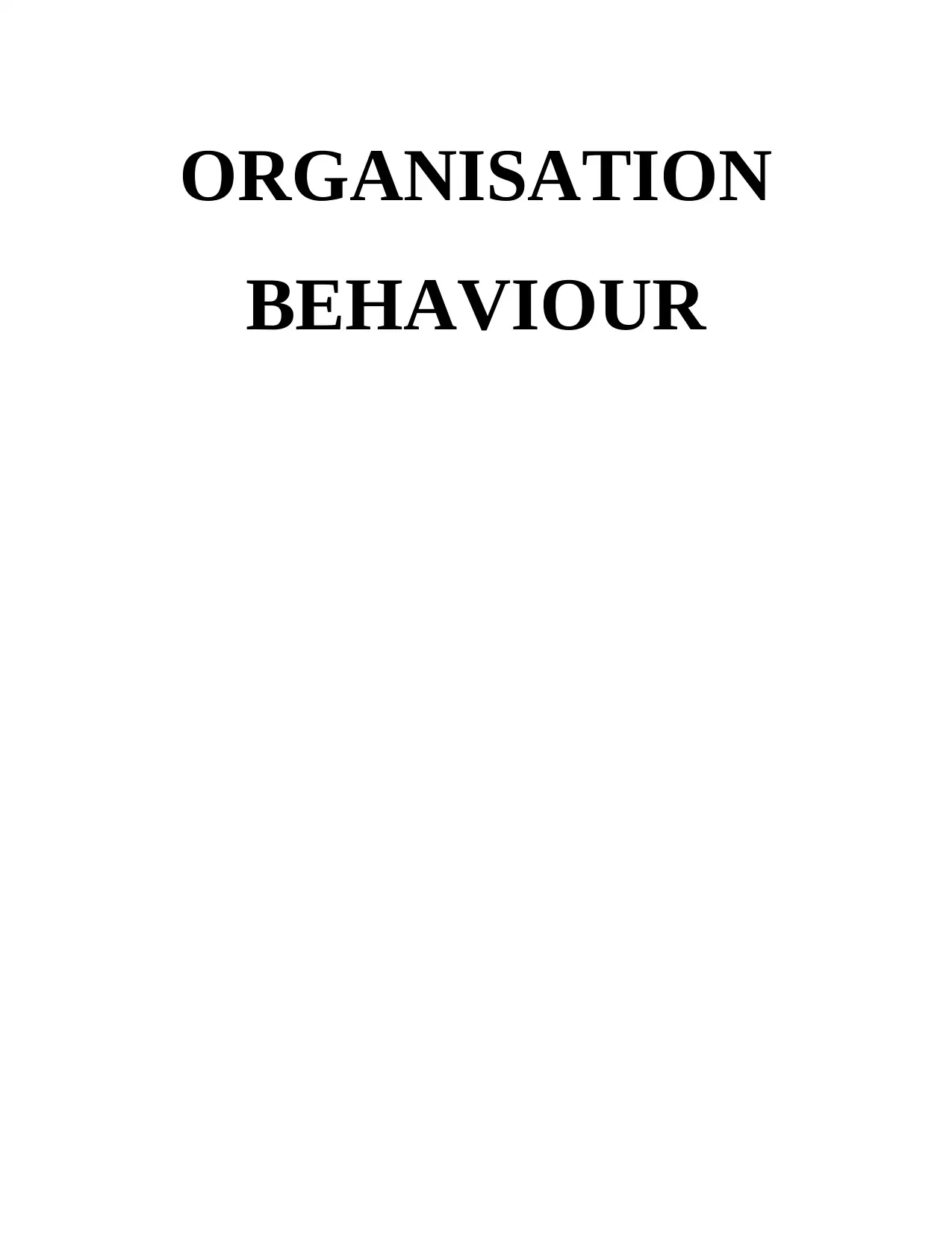
ORGANISATION
BEHAVIOUR
BEHAVIOUR
Paraphrase This Document
Need a fresh take? Get an instant paraphrase of this document with our AI Paraphraser
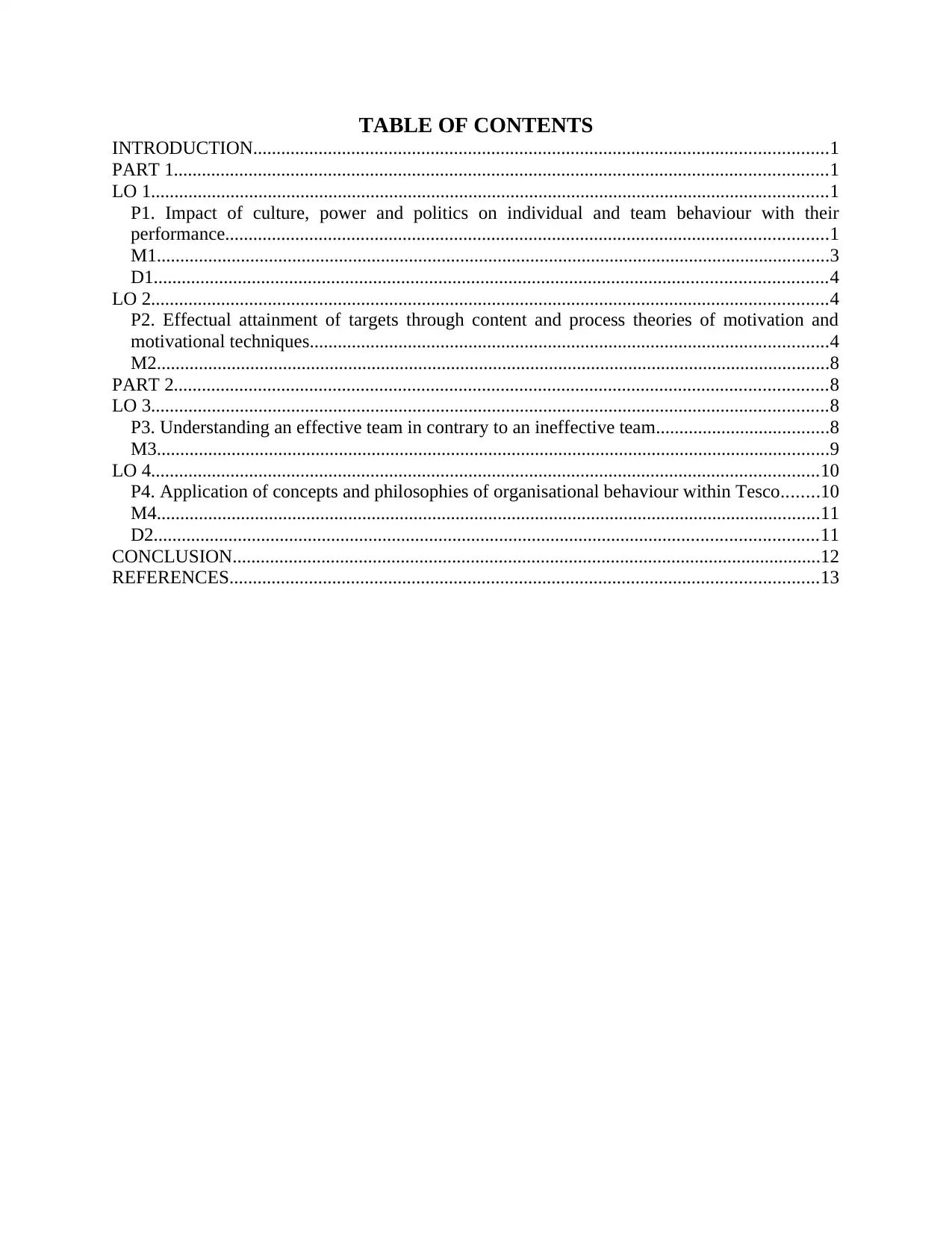
TABLE OF CONTENTS
INTRODUCTION...........................................................................................................................1
PART 1............................................................................................................................................1
LO 1.................................................................................................................................................1
P1. Impact of culture, power and politics on individual and team behaviour with their
performance.................................................................................................................................1
M1................................................................................................................................................3
D1................................................................................................................................................4
LO 2.................................................................................................................................................4
P2. Effectual attainment of targets through content and process theories of motivation and
motivational techniques...............................................................................................................4
M2................................................................................................................................................8
PART 2............................................................................................................................................8
LO 3.................................................................................................................................................8
P3. Understanding an effective team in contrary to an ineffective team.....................................8
M3................................................................................................................................................9
LO 4...............................................................................................................................................10
P4. Application of concepts and philosophies of organisational behaviour within Tesco........10
M4..............................................................................................................................................11
D2..............................................................................................................................................11
CONCLUSION..............................................................................................................................12
REFERENCES..............................................................................................................................13
INTRODUCTION...........................................................................................................................1
PART 1............................................................................................................................................1
LO 1.................................................................................................................................................1
P1. Impact of culture, power and politics on individual and team behaviour with their
performance.................................................................................................................................1
M1................................................................................................................................................3
D1................................................................................................................................................4
LO 2.................................................................................................................................................4
P2. Effectual attainment of targets through content and process theories of motivation and
motivational techniques...............................................................................................................4
M2................................................................................................................................................8
PART 2............................................................................................................................................8
LO 3.................................................................................................................................................8
P3. Understanding an effective team in contrary to an ineffective team.....................................8
M3................................................................................................................................................9
LO 4...............................................................................................................................................10
P4. Application of concepts and philosophies of organisational behaviour within Tesco........10
M4..............................................................................................................................................11
D2..............................................................................................................................................11
CONCLUSION..............................................................................................................................12
REFERENCES..............................................................................................................................13
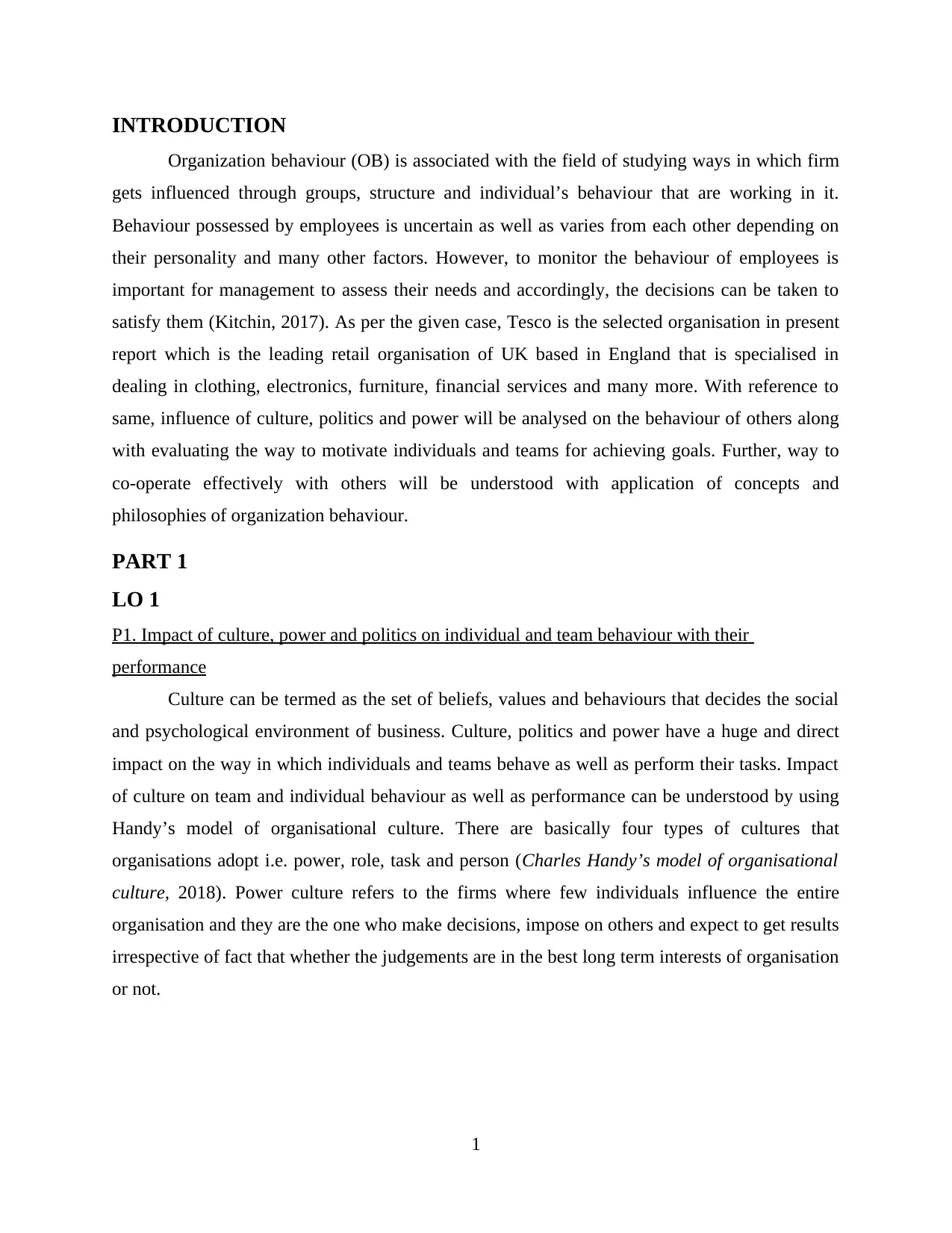
INTRODUCTION
Organization behaviour (OB) is associated with the field of studying ways in which firm
gets influenced through groups, structure and individual’s behaviour that are working in it.
Behaviour possessed by employees is uncertain as well as varies from each other depending on
their personality and many other factors. However, to monitor the behaviour of employees is
important for management to assess their needs and accordingly, the decisions can be taken to
satisfy them (Kitchin, 2017). As per the given case, Tesco is the selected organisation in present
report which is the leading retail organisation of UK based in England that is specialised in
dealing in clothing, electronics, furniture, financial services and many more. With reference to
same, influence of culture, politics and power will be analysed on the behaviour of others along
with evaluating the way to motivate individuals and teams for achieving goals. Further, way to
co-operate effectively with others will be understood with application of concepts and
philosophies of organization behaviour.
PART 1
LO 1
P1. Impact of culture, power and politics on individual and team behaviour with their
performance
Culture can be termed as the set of beliefs, values and behaviours that decides the social
and psychological environment of business. Culture, politics and power have a huge and direct
impact on the way in which individuals and teams behave as well as perform their tasks. Impact
of culture on team and individual behaviour as well as performance can be understood by using
Handy’s model of organisational culture. There are basically four types of cultures that
organisations adopt i.e. power, role, task and person (Charles Handy’s model of organisational
culture, 2018). Power culture refers to the firms where few individuals influence the entire
organisation and they are the one who make decisions, impose on others and expect to get results
irrespective of fact that whether the judgements are in the best long term interests of organisation
or not.
1
Organization behaviour (OB) is associated with the field of studying ways in which firm
gets influenced through groups, structure and individual’s behaviour that are working in it.
Behaviour possessed by employees is uncertain as well as varies from each other depending on
their personality and many other factors. However, to monitor the behaviour of employees is
important for management to assess their needs and accordingly, the decisions can be taken to
satisfy them (Kitchin, 2017). As per the given case, Tesco is the selected organisation in present
report which is the leading retail organisation of UK based in England that is specialised in
dealing in clothing, electronics, furniture, financial services and many more. With reference to
same, influence of culture, politics and power will be analysed on the behaviour of others along
with evaluating the way to motivate individuals and teams for achieving goals. Further, way to
co-operate effectively with others will be understood with application of concepts and
philosophies of organization behaviour.
PART 1
LO 1
P1. Impact of culture, power and politics on individual and team behaviour with their
performance
Culture can be termed as the set of beliefs, values and behaviours that decides the social
and psychological environment of business. Culture, politics and power have a huge and direct
impact on the way in which individuals and teams behave as well as perform their tasks. Impact
of culture on team and individual behaviour as well as performance can be understood by using
Handy’s model of organisational culture. There are basically four types of cultures that
organisations adopt i.e. power, role, task and person (Charles Handy’s model of organisational
culture, 2018). Power culture refers to the firms where few individuals influence the entire
organisation and they are the one who make decisions, impose on others and expect to get results
irrespective of fact that whether the judgements are in the best long term interests of organisation
or not.
1
⊘ This is a preview!⊘
Do you want full access?
Subscribe today to unlock all pages.

Trusted by 1+ million students worldwide
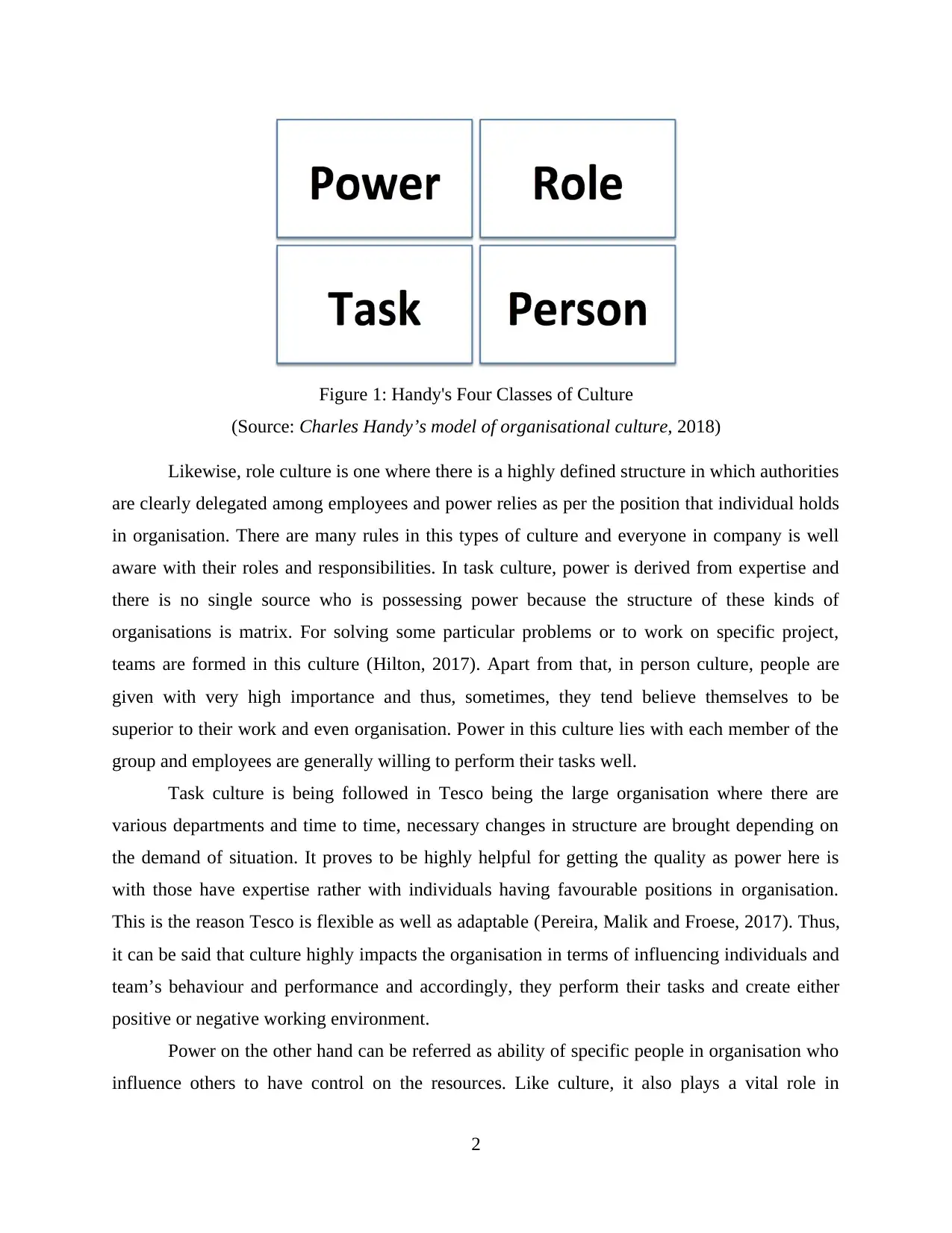
Figure 1: Handy's Four Classes of Culture
(Source: Charles Handy’s model of organisational culture, 2018)
Likewise, role culture is one where there is a highly defined structure in which authorities
are clearly delegated among employees and power relies as per the position that individual holds
in organisation. There are many rules in this types of culture and everyone in company is well
aware with their roles and responsibilities. In task culture, power is derived from expertise and
there is no single source who is possessing power because the structure of these kinds of
organisations is matrix. For solving some particular problems or to work on specific project,
teams are formed in this culture (Hilton, 2017). Apart from that, in person culture, people are
given with very high importance and thus, sometimes, they tend believe themselves to be
superior to their work and even organisation. Power in this culture lies with each member of the
group and employees are generally willing to perform their tasks well.
Task culture is being followed in Tesco being the large organisation where there are
various departments and time to time, necessary changes in structure are brought depending on
the demand of situation. It proves to be highly helpful for getting the quality as power here is
with those have expertise rather with individuals having favourable positions in organisation.
This is the reason Tesco is flexible as well as adaptable (Pereira, Malik and Froese, 2017). Thus,
it can be said that culture highly impacts the organisation in terms of influencing individuals and
team’s behaviour and performance and accordingly, they perform their tasks and create either
positive or negative working environment.
Power on the other hand can be referred as ability of specific people in organisation who
influence others to have control on the resources. Like culture, it also plays a vital role in
2
(Source: Charles Handy’s model of organisational culture, 2018)
Likewise, role culture is one where there is a highly defined structure in which authorities
are clearly delegated among employees and power relies as per the position that individual holds
in organisation. There are many rules in this types of culture and everyone in company is well
aware with their roles and responsibilities. In task culture, power is derived from expertise and
there is no single source who is possessing power because the structure of these kinds of
organisations is matrix. For solving some particular problems or to work on specific project,
teams are formed in this culture (Hilton, 2017). Apart from that, in person culture, people are
given with very high importance and thus, sometimes, they tend believe themselves to be
superior to their work and even organisation. Power in this culture lies with each member of the
group and employees are generally willing to perform their tasks well.
Task culture is being followed in Tesco being the large organisation where there are
various departments and time to time, necessary changes in structure are brought depending on
the demand of situation. It proves to be highly helpful for getting the quality as power here is
with those have expertise rather with individuals having favourable positions in organisation.
This is the reason Tesco is flexible as well as adaptable (Pereira, Malik and Froese, 2017). Thus,
it can be said that culture highly impacts the organisation in terms of influencing individuals and
team’s behaviour and performance and accordingly, they perform their tasks and create either
positive or negative working environment.
Power on the other hand can be referred as ability of specific people in organisation who
influence others to have control on the resources. Like culture, it also plays a vital role in
2
Paraphrase This Document
Need a fresh take? Get an instant paraphrase of this document with our AI Paraphraser
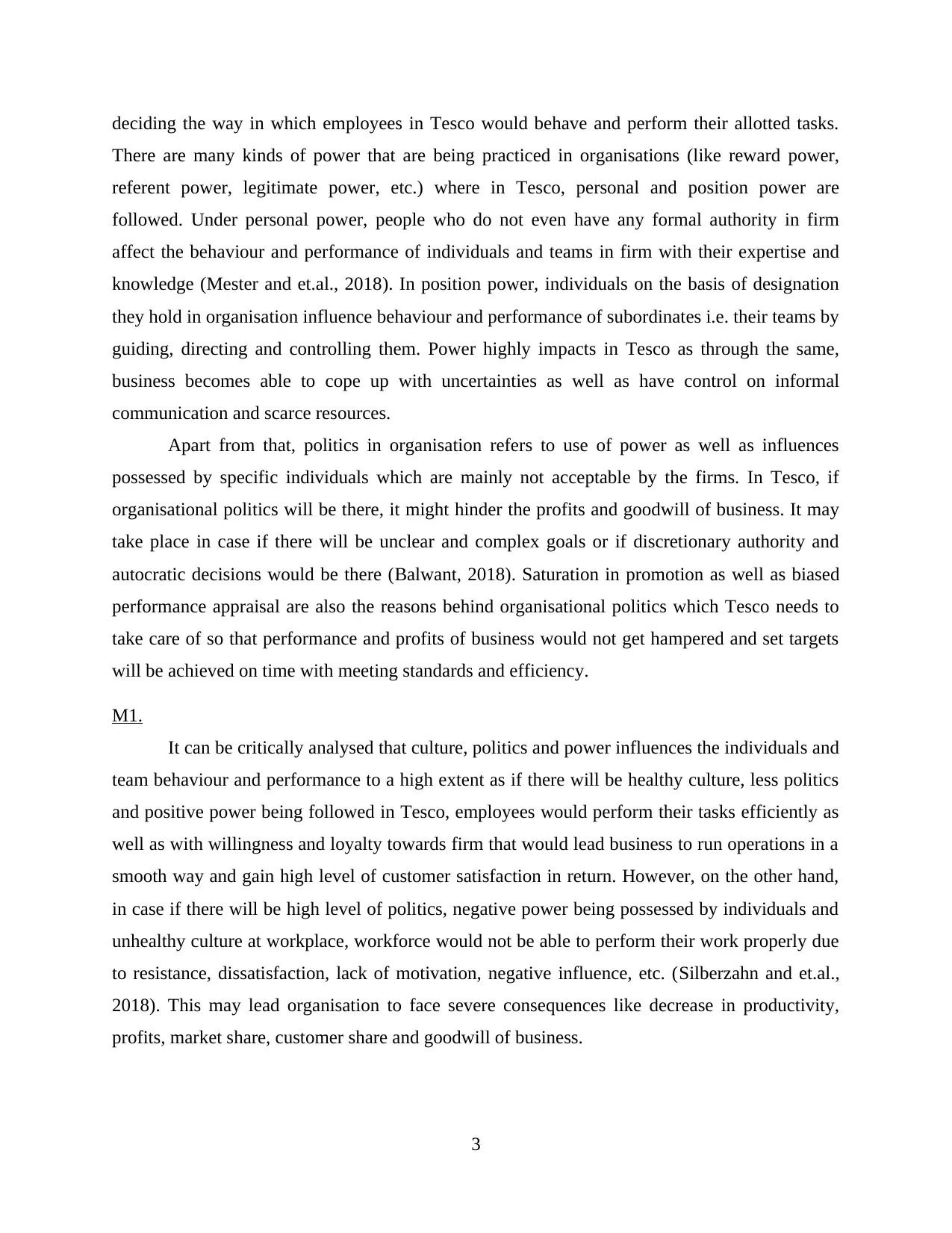
deciding the way in which employees in Tesco would behave and perform their allotted tasks.
There are many kinds of power that are being practiced in organisations (like reward power,
referent power, legitimate power, etc.) where in Tesco, personal and position power are
followed. Under personal power, people who do not even have any formal authority in firm
affect the behaviour and performance of individuals and teams in firm with their expertise and
knowledge (Mester and et.al., 2018). In position power, individuals on the basis of designation
they hold in organisation influence behaviour and performance of subordinates i.e. their teams by
guiding, directing and controlling them. Power highly impacts in Tesco as through the same,
business becomes able to cope up with uncertainties as well as have control on informal
communication and scarce resources.
Apart from that, politics in organisation refers to use of power as well as influences
possessed by specific individuals which are mainly not acceptable by the firms. In Tesco, if
organisational politics will be there, it might hinder the profits and goodwill of business. It may
take place in case if there will be unclear and complex goals or if discretionary authority and
autocratic decisions would be there (Balwant, 2018). Saturation in promotion as well as biased
performance appraisal are also the reasons behind organisational politics which Tesco needs to
take care of so that performance and profits of business would not get hampered and set targets
will be achieved on time with meeting standards and efficiency.
M1.
It can be critically analysed that culture, politics and power influences the individuals and
team behaviour and performance to a high extent as if there will be healthy culture, less politics
and positive power being followed in Tesco, employees would perform their tasks efficiently as
well as with willingness and loyalty towards firm that would lead business to run operations in a
smooth way and gain high level of customer satisfaction in return. However, on the other hand,
in case if there will be high level of politics, negative power being possessed by individuals and
unhealthy culture at workplace, workforce would not be able to perform their work properly due
to resistance, dissatisfaction, lack of motivation, negative influence, etc. (Silberzahn and et.al.,
2018). This may lead organisation to face severe consequences like decrease in productivity,
profits, market share, customer share and goodwill of business.
3
There are many kinds of power that are being practiced in organisations (like reward power,
referent power, legitimate power, etc.) where in Tesco, personal and position power are
followed. Under personal power, people who do not even have any formal authority in firm
affect the behaviour and performance of individuals and teams in firm with their expertise and
knowledge (Mester and et.al., 2018). In position power, individuals on the basis of designation
they hold in organisation influence behaviour and performance of subordinates i.e. their teams by
guiding, directing and controlling them. Power highly impacts in Tesco as through the same,
business becomes able to cope up with uncertainties as well as have control on informal
communication and scarce resources.
Apart from that, politics in organisation refers to use of power as well as influences
possessed by specific individuals which are mainly not acceptable by the firms. In Tesco, if
organisational politics will be there, it might hinder the profits and goodwill of business. It may
take place in case if there will be unclear and complex goals or if discretionary authority and
autocratic decisions would be there (Balwant, 2018). Saturation in promotion as well as biased
performance appraisal are also the reasons behind organisational politics which Tesco needs to
take care of so that performance and profits of business would not get hampered and set targets
will be achieved on time with meeting standards and efficiency.
M1.
It can be critically analysed that culture, politics and power influences the individuals and
team behaviour and performance to a high extent as if there will be healthy culture, less politics
and positive power being followed in Tesco, employees would perform their tasks efficiently as
well as with willingness and loyalty towards firm that would lead business to run operations in a
smooth way and gain high level of customer satisfaction in return. However, on the other hand,
in case if there will be high level of politics, negative power being possessed by individuals and
unhealthy culture at workplace, workforce would not be able to perform their work properly due
to resistance, dissatisfaction, lack of motivation, negative influence, etc. (Silberzahn and et.al.,
2018). This may lead organisation to face severe consequences like decrease in productivity,
profits, market share, customer share and goodwill of business.
3
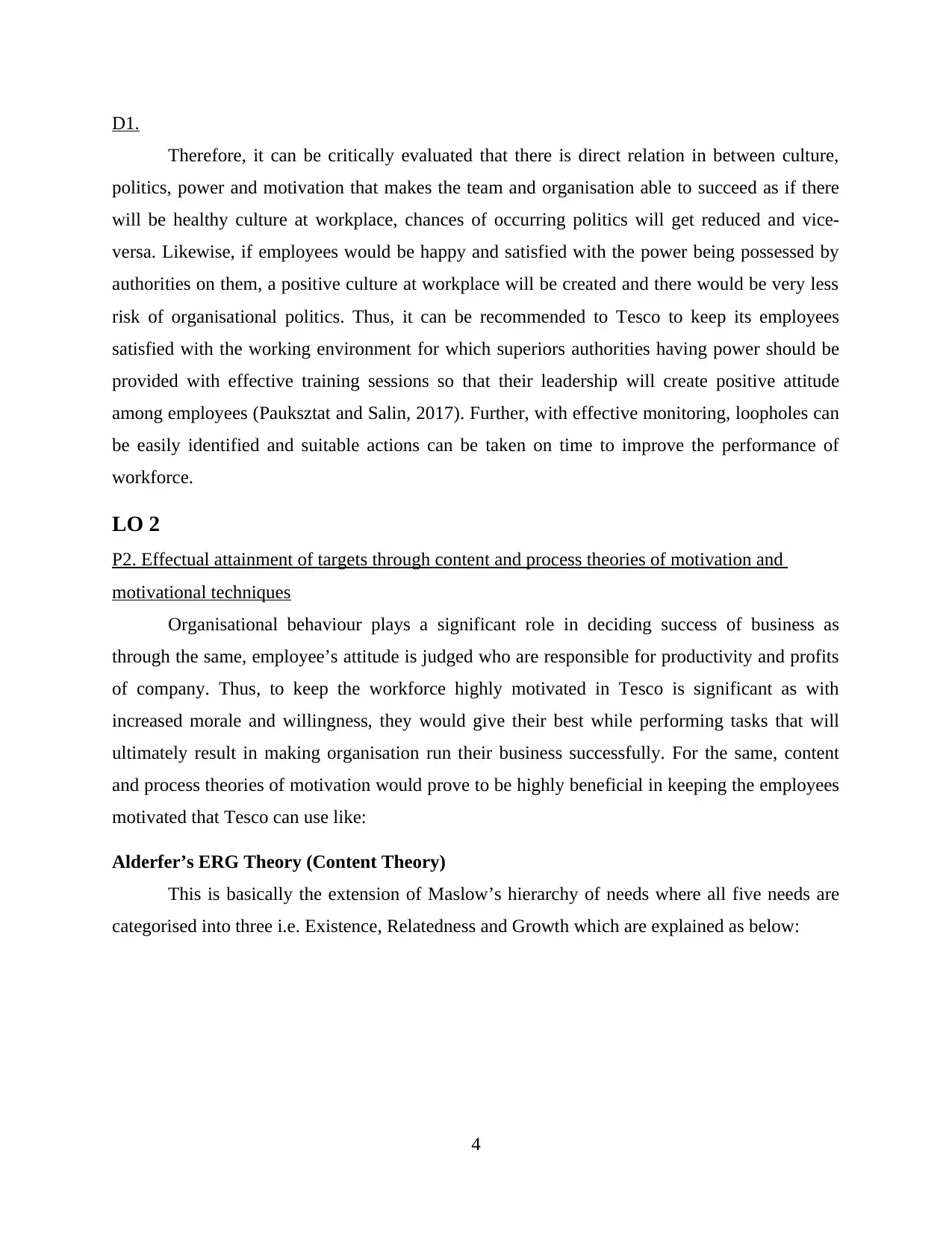
D1.
Therefore, it can be critically evaluated that there is direct relation in between culture,
politics, power and motivation that makes the team and organisation able to succeed as if there
will be healthy culture at workplace, chances of occurring politics will get reduced and vice-
versa. Likewise, if employees would be happy and satisfied with the power being possessed by
authorities on them, a positive culture at workplace will be created and there would be very less
risk of organisational politics. Thus, it can be recommended to Tesco to keep its employees
satisfied with the working environment for which superiors authorities having power should be
provided with effective training sessions so that their leadership will create positive attitude
among employees (Pauksztat and Salin, 2017). Further, with effective monitoring, loopholes can
be easily identified and suitable actions can be taken on time to improve the performance of
workforce.
LO 2
P2. Effectual attainment of targets through content and process theories of motivation and
motivational techniques
Organisational behaviour plays a significant role in deciding success of business as
through the same, employee’s attitude is judged who are responsible for productivity and profits
of company. Thus, to keep the workforce highly motivated in Tesco is significant as with
increased morale and willingness, they would give their best while performing tasks that will
ultimately result in making organisation run their business successfully. For the same, content
and process theories of motivation would prove to be highly beneficial in keeping the employees
motivated that Tesco can use like:
Alderfer’s ERG Theory (Content Theory)
This is basically the extension of Maslow’s hierarchy of needs where all five needs are
categorised into three i.e. Existence, Relatedness and Growth which are explained as below:
4
Therefore, it can be critically evaluated that there is direct relation in between culture,
politics, power and motivation that makes the team and organisation able to succeed as if there
will be healthy culture at workplace, chances of occurring politics will get reduced and vice-
versa. Likewise, if employees would be happy and satisfied with the power being possessed by
authorities on them, a positive culture at workplace will be created and there would be very less
risk of organisational politics. Thus, it can be recommended to Tesco to keep its employees
satisfied with the working environment for which superiors authorities having power should be
provided with effective training sessions so that their leadership will create positive attitude
among employees (Pauksztat and Salin, 2017). Further, with effective monitoring, loopholes can
be easily identified and suitable actions can be taken on time to improve the performance of
workforce.
LO 2
P2. Effectual attainment of targets through content and process theories of motivation and
motivational techniques
Organisational behaviour plays a significant role in deciding success of business as
through the same, employee’s attitude is judged who are responsible for productivity and profits
of company. Thus, to keep the workforce highly motivated in Tesco is significant as with
increased morale and willingness, they would give their best while performing tasks that will
ultimately result in making organisation run their business successfully. For the same, content
and process theories of motivation would prove to be highly beneficial in keeping the employees
motivated that Tesco can use like:
Alderfer’s ERG Theory (Content Theory)
This is basically the extension of Maslow’s hierarchy of needs where all five needs are
categorised into three i.e. Existence, Relatedness and Growth which are explained as below:
4
⊘ This is a preview!⊘
Do you want full access?
Subscribe today to unlock all pages.

Trusted by 1+ million students worldwide
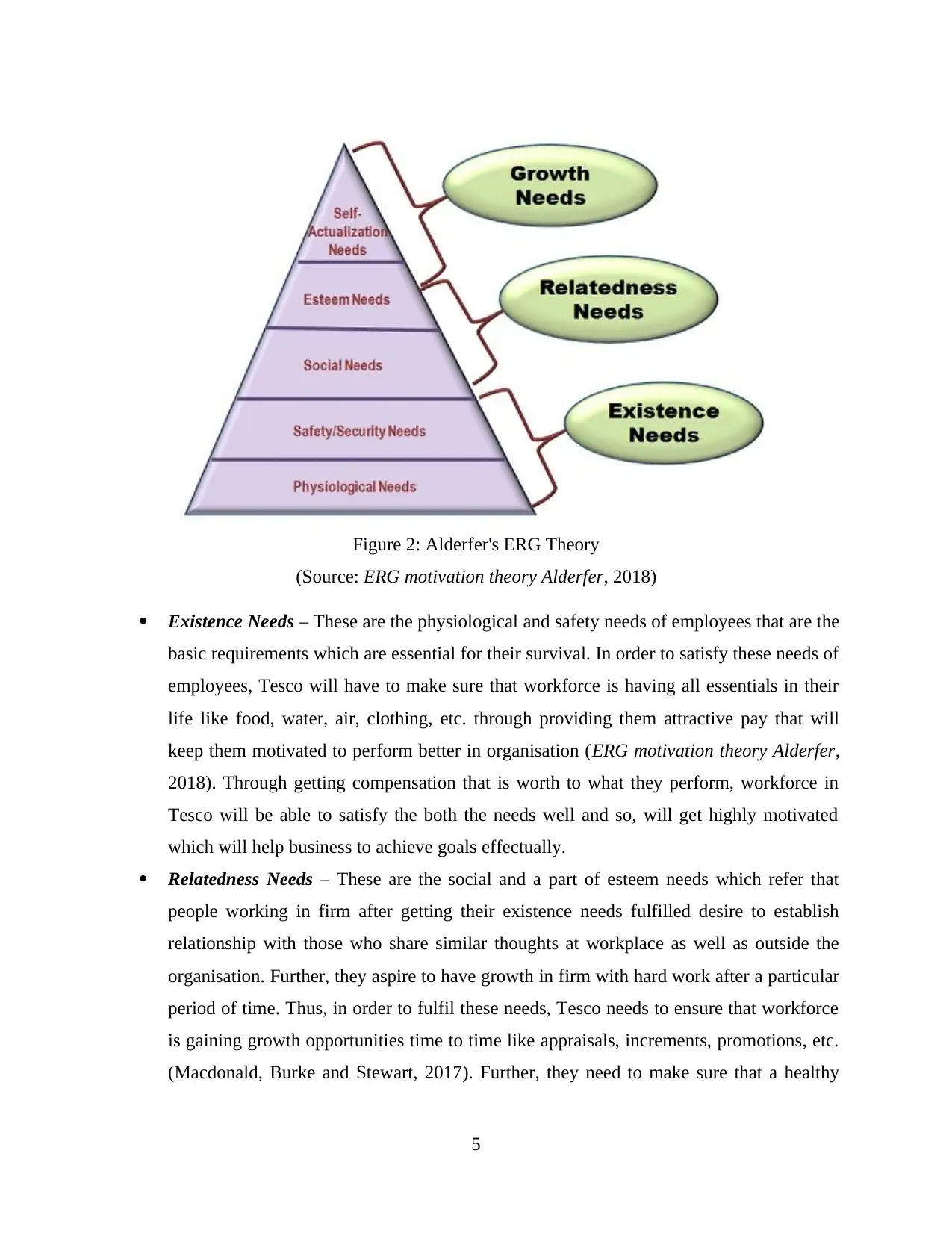
Figure 2: Alderfer's ERG Theory
(Source: ERG motivation theory Alderfer, 2018)
Existence Needs – These are the physiological and safety needs of employees that are the
basic requirements which are essential for their survival. In order to satisfy these needs of
employees, Tesco will have to make sure that workforce is having all essentials in their
life like food, water, air, clothing, etc. through providing them attractive pay that will
keep them motivated to perform better in organisation (ERG motivation theory Alderfer,
2018). Through getting compensation that is worth to what they perform, workforce in
Tesco will be able to satisfy the both the needs well and so, will get highly motivated
which will help business to achieve goals effectually.
Relatedness Needs – These are the social and a part of esteem needs which refer that
people working in firm after getting their existence needs fulfilled desire to establish
relationship with those who share similar thoughts at workplace as well as outside the
organisation. Further, they aspire to have growth in firm with hard work after a particular
period of time. Thus, in order to fulfil these needs, Tesco needs to ensure that workforce
is gaining growth opportunities time to time like appraisals, increments, promotions, etc.
(Macdonald, Burke and Stewart, 2017). Further, they need to make sure that a healthy
5
(Source: ERG motivation theory Alderfer, 2018)
Existence Needs – These are the physiological and safety needs of employees that are the
basic requirements which are essential for their survival. In order to satisfy these needs of
employees, Tesco will have to make sure that workforce is having all essentials in their
life like food, water, air, clothing, etc. through providing them attractive pay that will
keep them motivated to perform better in organisation (ERG motivation theory Alderfer,
2018). Through getting compensation that is worth to what they perform, workforce in
Tesco will be able to satisfy the both the needs well and so, will get highly motivated
which will help business to achieve goals effectually.
Relatedness Needs – These are the social and a part of esteem needs which refer that
people working in firm after getting their existence needs fulfilled desire to establish
relationship with those who share similar thoughts at workplace as well as outside the
organisation. Further, they aspire to have growth in firm with hard work after a particular
period of time. Thus, in order to fulfil these needs, Tesco needs to ensure that workforce
is gaining growth opportunities time to time like appraisals, increments, promotions, etc.
(Macdonald, Burke and Stewart, 2017). Further, they need to make sure that a healthy
5
Paraphrase This Document
Need a fresh take? Get an instant paraphrase of this document with our AI Paraphraser
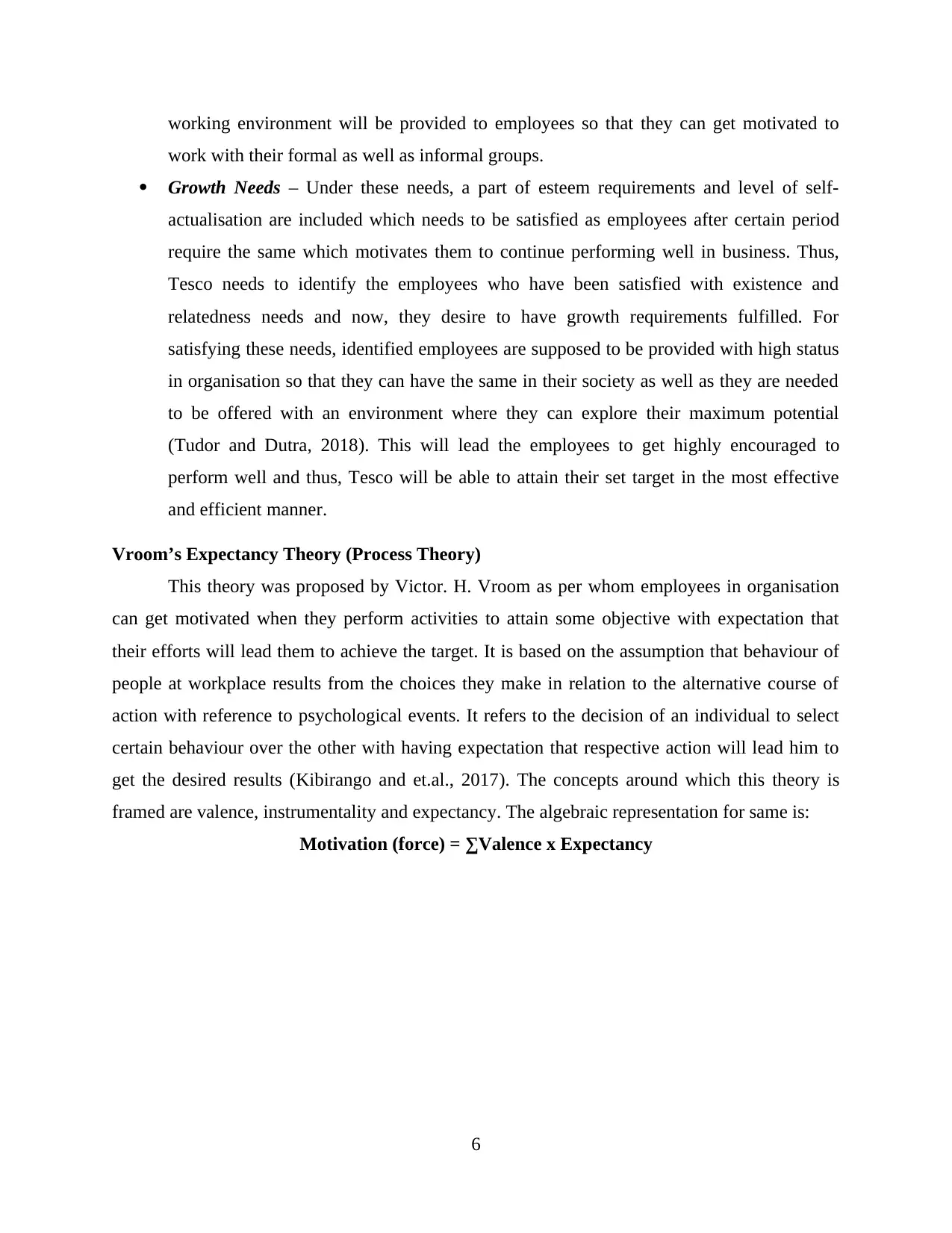
working environment will be provided to employees so that they can get motivated to
work with their formal as well as informal groups.
Growth Needs – Under these needs, a part of esteem requirements and level of self-
actualisation are included which needs to be satisfied as employees after certain period
require the same which motivates them to continue performing well in business. Thus,
Tesco needs to identify the employees who have been satisfied with existence and
relatedness needs and now, they desire to have growth requirements fulfilled. For
satisfying these needs, identified employees are supposed to be provided with high status
in organisation so that they can have the same in their society as well as they are needed
to be offered with an environment where they can explore their maximum potential
(Tudor and Dutra, 2018). This will lead the employees to get highly encouraged to
perform well and thus, Tesco will be able to attain their set target in the most effective
and efficient manner.
Vroom’s Expectancy Theory (Process Theory)
This theory was proposed by Victor. H. Vroom as per whom employees in organisation
can get motivated when they perform activities to attain some objective with expectation that
their efforts will lead them to achieve the target. It is based on the assumption that behaviour of
people at workplace results from the choices they make in relation to the alternative course of
action with reference to psychological events. It refers to the decision of an individual to select
certain behaviour over the other with having expectation that respective action will lead him to
get the desired results (Kibirango and et.al., 2017). The concepts around which this theory is
framed are valence, instrumentality and expectancy. The algebraic representation for same is:
Motivation (force) = ∑Valence x Expectancy
6
work with their formal as well as informal groups.
Growth Needs – Under these needs, a part of esteem requirements and level of self-
actualisation are included which needs to be satisfied as employees after certain period
require the same which motivates them to continue performing well in business. Thus,
Tesco needs to identify the employees who have been satisfied with existence and
relatedness needs and now, they desire to have growth requirements fulfilled. For
satisfying these needs, identified employees are supposed to be provided with high status
in organisation so that they can have the same in their society as well as they are needed
to be offered with an environment where they can explore their maximum potential
(Tudor and Dutra, 2018). This will lead the employees to get highly encouraged to
perform well and thus, Tesco will be able to attain their set target in the most effective
and efficient manner.
Vroom’s Expectancy Theory (Process Theory)
This theory was proposed by Victor. H. Vroom as per whom employees in organisation
can get motivated when they perform activities to attain some objective with expectation that
their efforts will lead them to achieve the target. It is based on the assumption that behaviour of
people at workplace results from the choices they make in relation to the alternative course of
action with reference to psychological events. It refers to the decision of an individual to select
certain behaviour over the other with having expectation that respective action will lead him to
get the desired results (Kibirango and et.al., 2017). The concepts around which this theory is
framed are valence, instrumentality and expectancy. The algebraic representation for same is:
Motivation (force) = ∑Valence x Expectancy
6
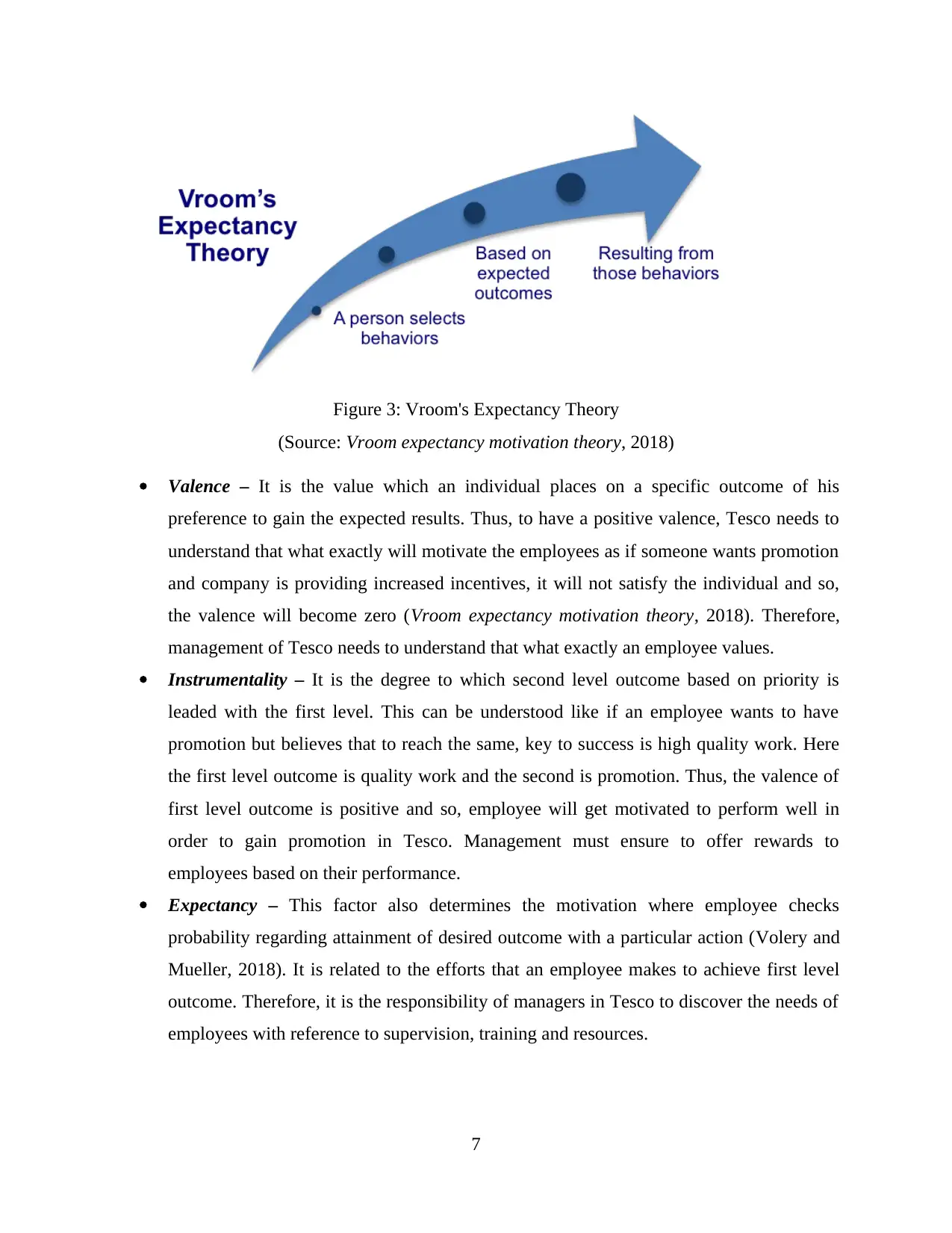
Figure 3: Vroom's Expectancy Theory
(Source: Vroom expectancy motivation theory, 2018)
Valence – It is the value which an individual places on a specific outcome of his
preference to gain the expected results. Thus, to have a positive valence, Tesco needs to
understand that what exactly will motivate the employees as if someone wants promotion
and company is providing increased incentives, it will not satisfy the individual and so,
the valence will become zero (Vroom expectancy motivation theory, 2018). Therefore,
management of Tesco needs to understand that what exactly an employee values.
Instrumentality – It is the degree to which second level outcome based on priority is
leaded with the first level. This can be understood like if an employee wants to have
promotion but believes that to reach the same, key to success is high quality work. Here
the first level outcome is quality work and the second is promotion. Thus, the valence of
first level outcome is positive and so, employee will get motivated to perform well in
order to gain promotion in Tesco. Management must ensure to offer rewards to
employees based on their performance.
Expectancy – This factor also determines the motivation where employee checks
probability regarding attainment of desired outcome with a particular action (Volery and
Mueller, 2018). It is related to the efforts that an employee makes to achieve first level
outcome. Therefore, it is the responsibility of managers in Tesco to discover the needs of
employees with reference to supervision, training and resources.
7
(Source: Vroom expectancy motivation theory, 2018)
Valence – It is the value which an individual places on a specific outcome of his
preference to gain the expected results. Thus, to have a positive valence, Tesco needs to
understand that what exactly will motivate the employees as if someone wants promotion
and company is providing increased incentives, it will not satisfy the individual and so,
the valence will become zero (Vroom expectancy motivation theory, 2018). Therefore,
management of Tesco needs to understand that what exactly an employee values.
Instrumentality – It is the degree to which second level outcome based on priority is
leaded with the first level. This can be understood like if an employee wants to have
promotion but believes that to reach the same, key to success is high quality work. Here
the first level outcome is quality work and the second is promotion. Thus, the valence of
first level outcome is positive and so, employee will get motivated to perform well in
order to gain promotion in Tesco. Management must ensure to offer rewards to
employees based on their performance.
Expectancy – This factor also determines the motivation where employee checks
probability regarding attainment of desired outcome with a particular action (Volery and
Mueller, 2018). It is related to the efforts that an employee makes to achieve first level
outcome. Therefore, it is the responsibility of managers in Tesco to discover the needs of
employees with reference to supervision, training and resources.
7
⊘ This is a preview!⊘
Do you want full access?
Subscribe today to unlock all pages.

Trusted by 1+ million students worldwide
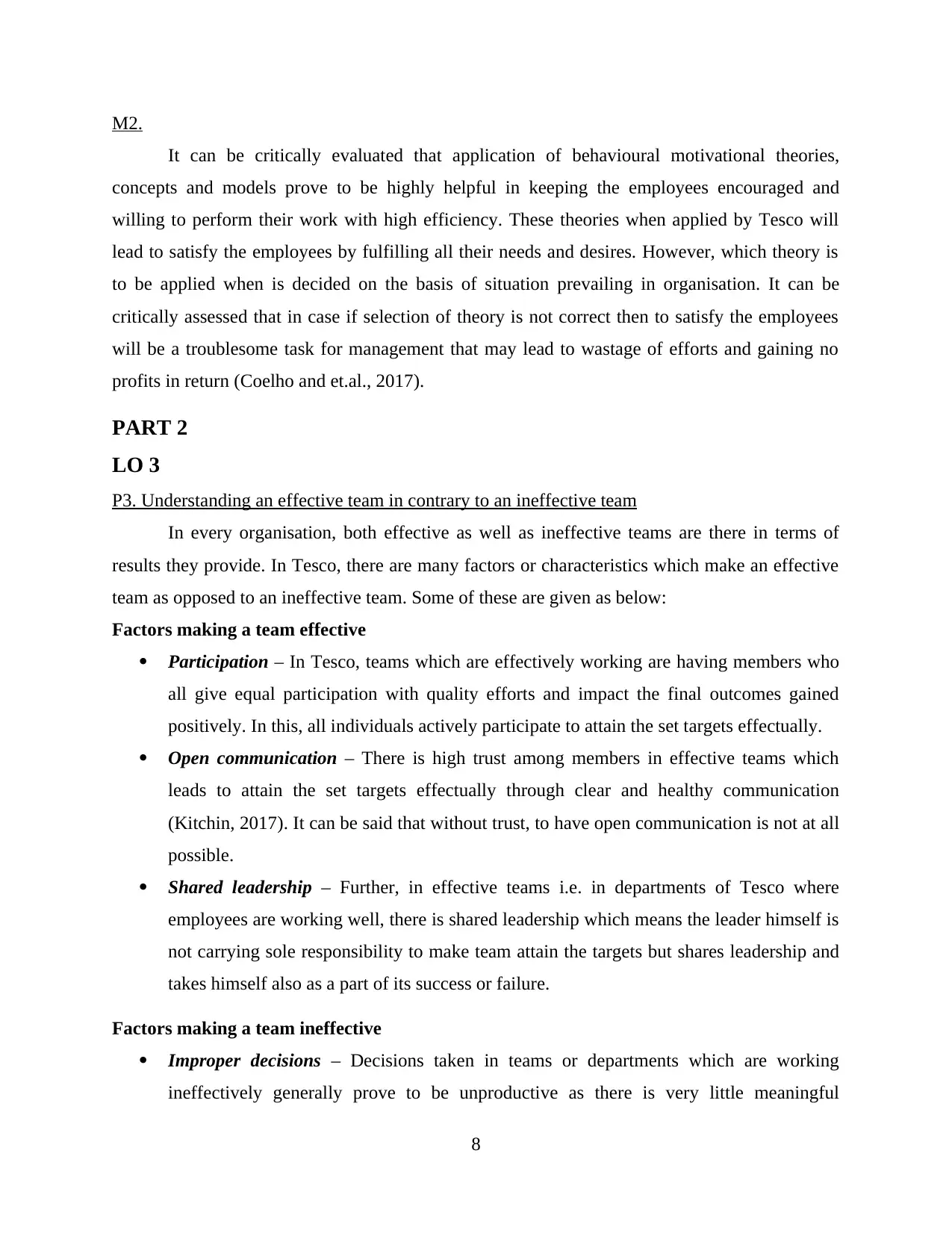
M2.
It can be critically evaluated that application of behavioural motivational theories,
concepts and models prove to be highly helpful in keeping the employees encouraged and
willing to perform their work with high efficiency. These theories when applied by Tesco will
lead to satisfy the employees by fulfilling all their needs and desires. However, which theory is
to be applied when is decided on the basis of situation prevailing in organisation. It can be
critically assessed that in case if selection of theory is not correct then to satisfy the employees
will be a troublesome task for management that may lead to wastage of efforts and gaining no
profits in return (Coelho and et.al., 2017).
PART 2
LO 3
P3. Understanding an effective team in contrary to an ineffective team
In every organisation, both effective as well as ineffective teams are there in terms of
results they provide. In Tesco, there are many factors or characteristics which make an effective
team as opposed to an ineffective team. Some of these are given as below:
Factors making a team effective
Participation – In Tesco, teams which are effectively working are having members who
all give equal participation with quality efforts and impact the final outcomes gained
positively. In this, all individuals actively participate to attain the set targets effectually.
Open communication – There is high trust among members in effective teams which
leads to attain the set targets effectually through clear and healthy communication
(Kitchin, 2017). It can be said that without trust, to have open communication is not at all
possible.
Shared leadership – Further, in effective teams i.e. in departments of Tesco where
employees are working well, there is shared leadership which means the leader himself is
not carrying sole responsibility to make team attain the targets but shares leadership and
takes himself also as a part of its success or failure.
Factors making a team ineffective
Improper decisions – Decisions taken in teams or departments which are working
ineffectively generally prove to be unproductive as there is very little meaningful
8
It can be critically evaluated that application of behavioural motivational theories,
concepts and models prove to be highly helpful in keeping the employees encouraged and
willing to perform their work with high efficiency. These theories when applied by Tesco will
lead to satisfy the employees by fulfilling all their needs and desires. However, which theory is
to be applied when is decided on the basis of situation prevailing in organisation. It can be
critically assessed that in case if selection of theory is not correct then to satisfy the employees
will be a troublesome task for management that may lead to wastage of efforts and gaining no
profits in return (Coelho and et.al., 2017).
PART 2
LO 3
P3. Understanding an effective team in contrary to an ineffective team
In every organisation, both effective as well as ineffective teams are there in terms of
results they provide. In Tesco, there are many factors or characteristics which make an effective
team as opposed to an ineffective team. Some of these are given as below:
Factors making a team effective
Participation – In Tesco, teams which are effectively working are having members who
all give equal participation with quality efforts and impact the final outcomes gained
positively. In this, all individuals actively participate to attain the set targets effectually.
Open communication – There is high trust among members in effective teams which
leads to attain the set targets effectually through clear and healthy communication
(Kitchin, 2017). It can be said that without trust, to have open communication is not at all
possible.
Shared leadership – Further, in effective teams i.e. in departments of Tesco where
employees are working well, there is shared leadership which means the leader himself is
not carrying sole responsibility to make team attain the targets but shares leadership and
takes himself also as a part of its success or failure.
Factors making a team ineffective
Improper decisions – Decisions taken in teams or departments which are working
ineffectively generally prove to be unproductive as there is very little meaningful
8
Paraphrase This Document
Need a fresh take? Get an instant paraphrase of this document with our AI Paraphraser
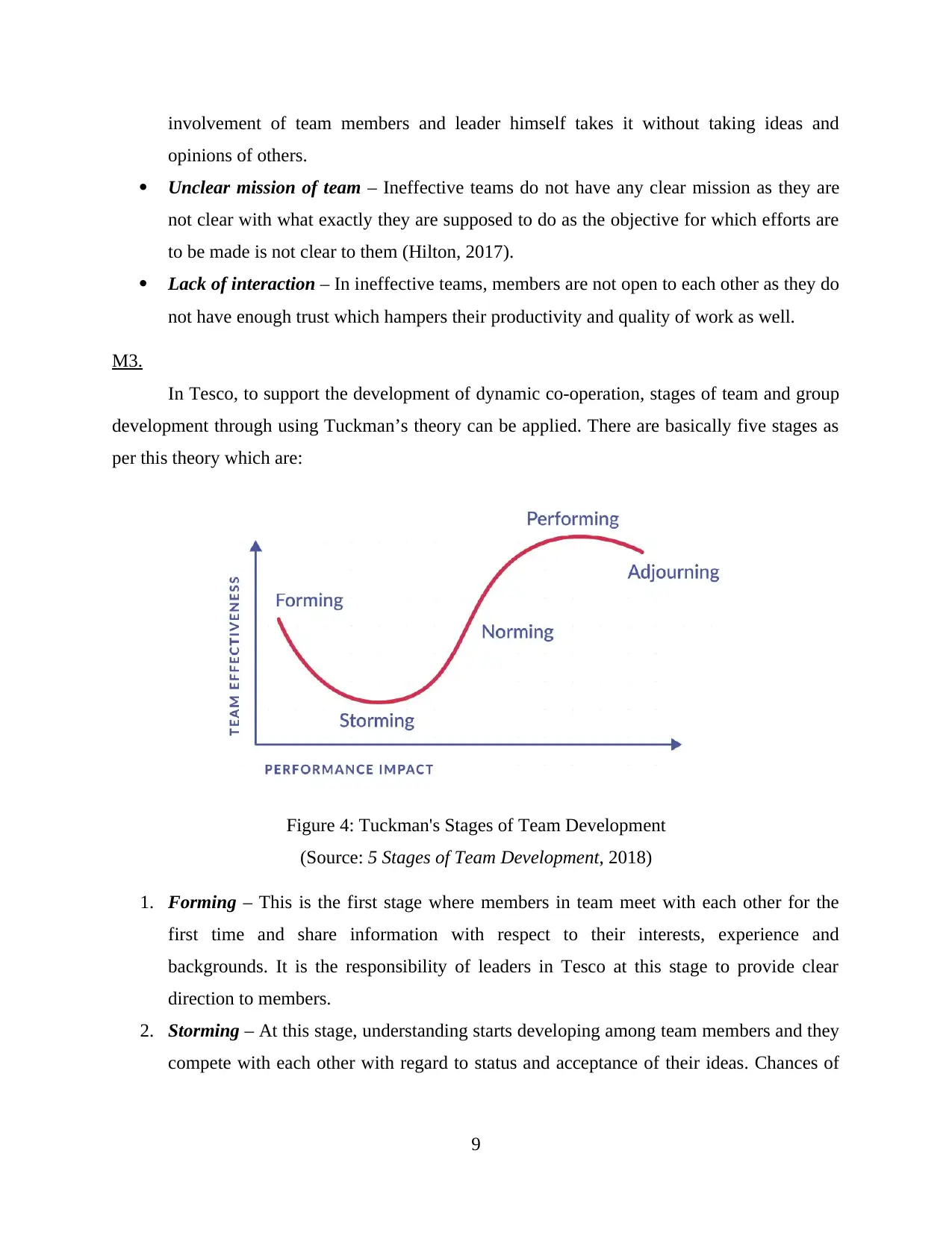
involvement of team members and leader himself takes it without taking ideas and
opinions of others.
Unclear mission of team – Ineffective teams do not have any clear mission as they are
not clear with what exactly they are supposed to do as the objective for which efforts are
to be made is not clear to them (Hilton, 2017).
Lack of interaction – In ineffective teams, members are not open to each other as they do
not have enough trust which hampers their productivity and quality of work as well.
M3.
In Tesco, to support the development of dynamic co-operation, stages of team and group
development through using Tuckman’s theory can be applied. There are basically five stages as
per this theory which are:
Figure 4: Tuckman's Stages of Team Development
(Source: 5 Stages of Team Development, 2018)
1. Forming – This is the first stage where members in team meet with each other for the
first time and share information with respect to their interests, experience and
backgrounds. It is the responsibility of leaders in Tesco at this stage to provide clear
direction to members.
2. Storming – At this stage, understanding starts developing among team members and they
compete with each other with regard to status and acceptance of their ideas. Chances of
9
opinions of others.
Unclear mission of team – Ineffective teams do not have any clear mission as they are
not clear with what exactly they are supposed to do as the objective for which efforts are
to be made is not clear to them (Hilton, 2017).
Lack of interaction – In ineffective teams, members are not open to each other as they do
not have enough trust which hampers their productivity and quality of work as well.
M3.
In Tesco, to support the development of dynamic co-operation, stages of team and group
development through using Tuckman’s theory can be applied. There are basically five stages as
per this theory which are:
Figure 4: Tuckman's Stages of Team Development
(Source: 5 Stages of Team Development, 2018)
1. Forming – This is the first stage where members in team meet with each other for the
first time and share information with respect to their interests, experience and
backgrounds. It is the responsibility of leaders in Tesco at this stage to provide clear
direction to members.
2. Storming – At this stage, understanding starts developing among team members and they
compete with each other with regard to status and acceptance of their ideas. Chances of
9
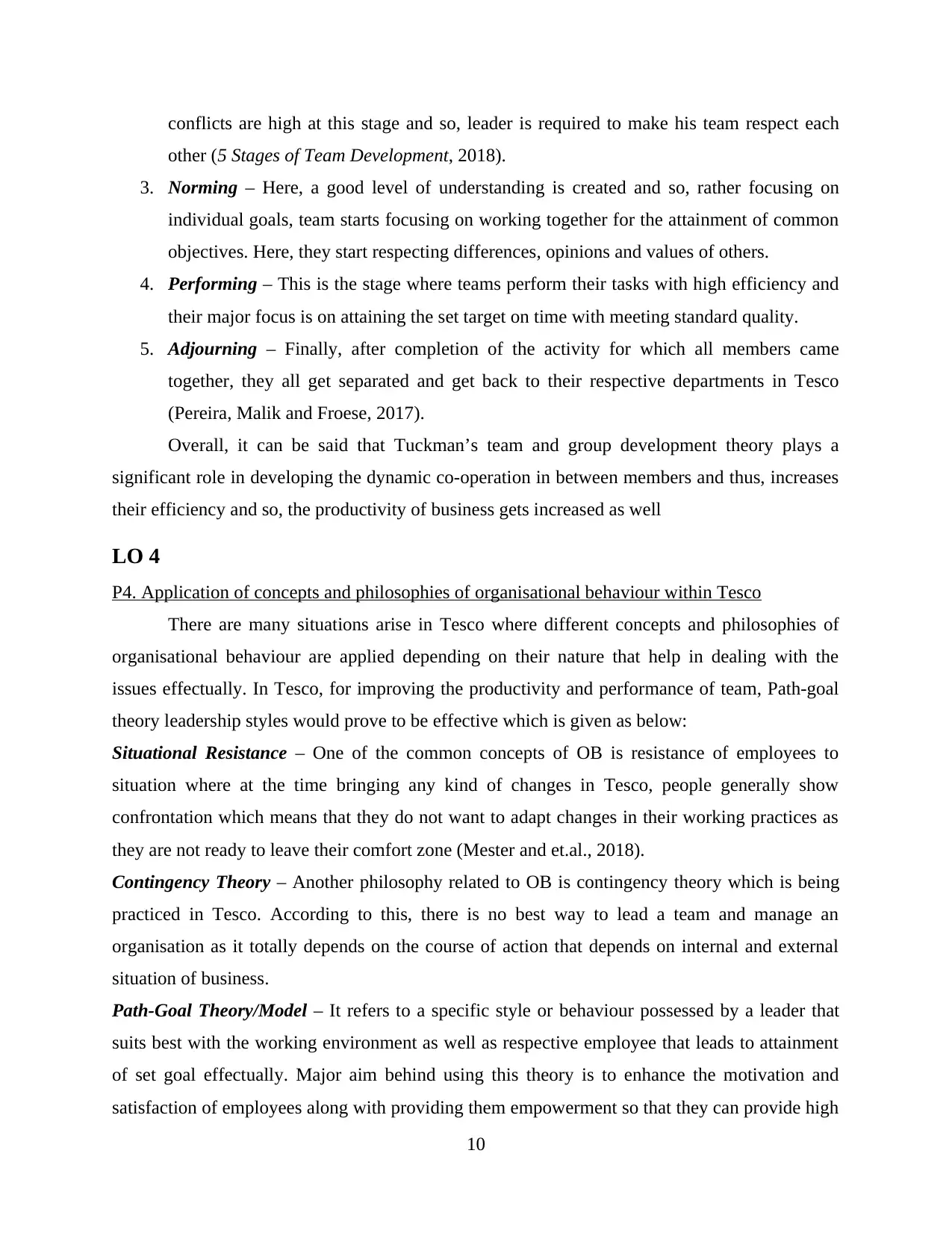
conflicts are high at this stage and so, leader is required to make his team respect each
other (5 Stages of Team Development, 2018).
3. Norming – Here, a good level of understanding is created and so, rather focusing on
individual goals, team starts focusing on working together for the attainment of common
objectives. Here, they start respecting differences, opinions and values of others.
4. Performing – This is the stage where teams perform their tasks with high efficiency and
their major focus is on attaining the set target on time with meeting standard quality.
5. Adjourning – Finally, after completion of the activity for which all members came
together, they all get separated and get back to their respective departments in Tesco
(Pereira, Malik and Froese, 2017).
Overall, it can be said that Tuckman’s team and group development theory plays a
significant role in developing the dynamic co-operation in between members and thus, increases
their efficiency and so, the productivity of business gets increased as well
LO 4
P4. Application of concepts and philosophies of organisational behaviour within Tesco
There are many situations arise in Tesco where different concepts and philosophies of
organisational behaviour are applied depending on their nature that help in dealing with the
issues effectually. In Tesco, for improving the productivity and performance of team, Path-goal
theory leadership styles would prove to be effective which is given as below:
Situational Resistance – One of the common concepts of OB is resistance of employees to
situation where at the time bringing any kind of changes in Tesco, people generally show
confrontation which means that they do not want to adapt changes in their working practices as
they are not ready to leave their comfort zone (Mester and et.al., 2018).
Contingency Theory – Another philosophy related to OB is contingency theory which is being
practiced in Tesco. According to this, there is no best way to lead a team and manage an
organisation as it totally depends on the course of action that depends on internal and external
situation of business.
Path-Goal Theory/Model – It refers to a specific style or behaviour possessed by a leader that
suits best with the working environment as well as respective employee that leads to attainment
of set goal effectually. Major aim behind using this theory is to enhance the motivation and
satisfaction of employees along with providing them empowerment so that they can provide high
10
other (5 Stages of Team Development, 2018).
3. Norming – Here, a good level of understanding is created and so, rather focusing on
individual goals, team starts focusing on working together for the attainment of common
objectives. Here, they start respecting differences, opinions and values of others.
4. Performing – This is the stage where teams perform their tasks with high efficiency and
their major focus is on attaining the set target on time with meeting standard quality.
5. Adjourning – Finally, after completion of the activity for which all members came
together, they all get separated and get back to their respective departments in Tesco
(Pereira, Malik and Froese, 2017).
Overall, it can be said that Tuckman’s team and group development theory plays a
significant role in developing the dynamic co-operation in between members and thus, increases
their efficiency and so, the productivity of business gets increased as well
LO 4
P4. Application of concepts and philosophies of organisational behaviour within Tesco
There are many situations arise in Tesco where different concepts and philosophies of
organisational behaviour are applied depending on their nature that help in dealing with the
issues effectually. In Tesco, for improving the productivity and performance of team, Path-goal
theory leadership styles would prove to be effective which is given as below:
Situational Resistance – One of the common concepts of OB is resistance of employees to
situation where at the time bringing any kind of changes in Tesco, people generally show
confrontation which means that they do not want to adapt changes in their working practices as
they are not ready to leave their comfort zone (Mester and et.al., 2018).
Contingency Theory – Another philosophy related to OB is contingency theory which is being
practiced in Tesco. According to this, there is no best way to lead a team and manage an
organisation as it totally depends on the course of action that depends on internal and external
situation of business.
Path-Goal Theory/Model – It refers to a specific style or behaviour possessed by a leader that
suits best with the working environment as well as respective employee that leads to attainment
of set goal effectually. Major aim behind using this theory is to enhance the motivation and
satisfaction of employees along with providing them empowerment so that they can provide high
10
⊘ This is a preview!⊘
Do you want full access?
Subscribe today to unlock all pages.

Trusted by 1+ million students worldwide
1 out of 17
Related Documents
Your All-in-One AI-Powered Toolkit for Academic Success.
+13062052269
info@desklib.com
Available 24*7 on WhatsApp / Email
![[object Object]](/_next/static/media/star-bottom.7253800d.svg)
Unlock your academic potential
Copyright © 2020–2025 A2Z Services. All Rights Reserved. Developed and managed by ZUCOL.





